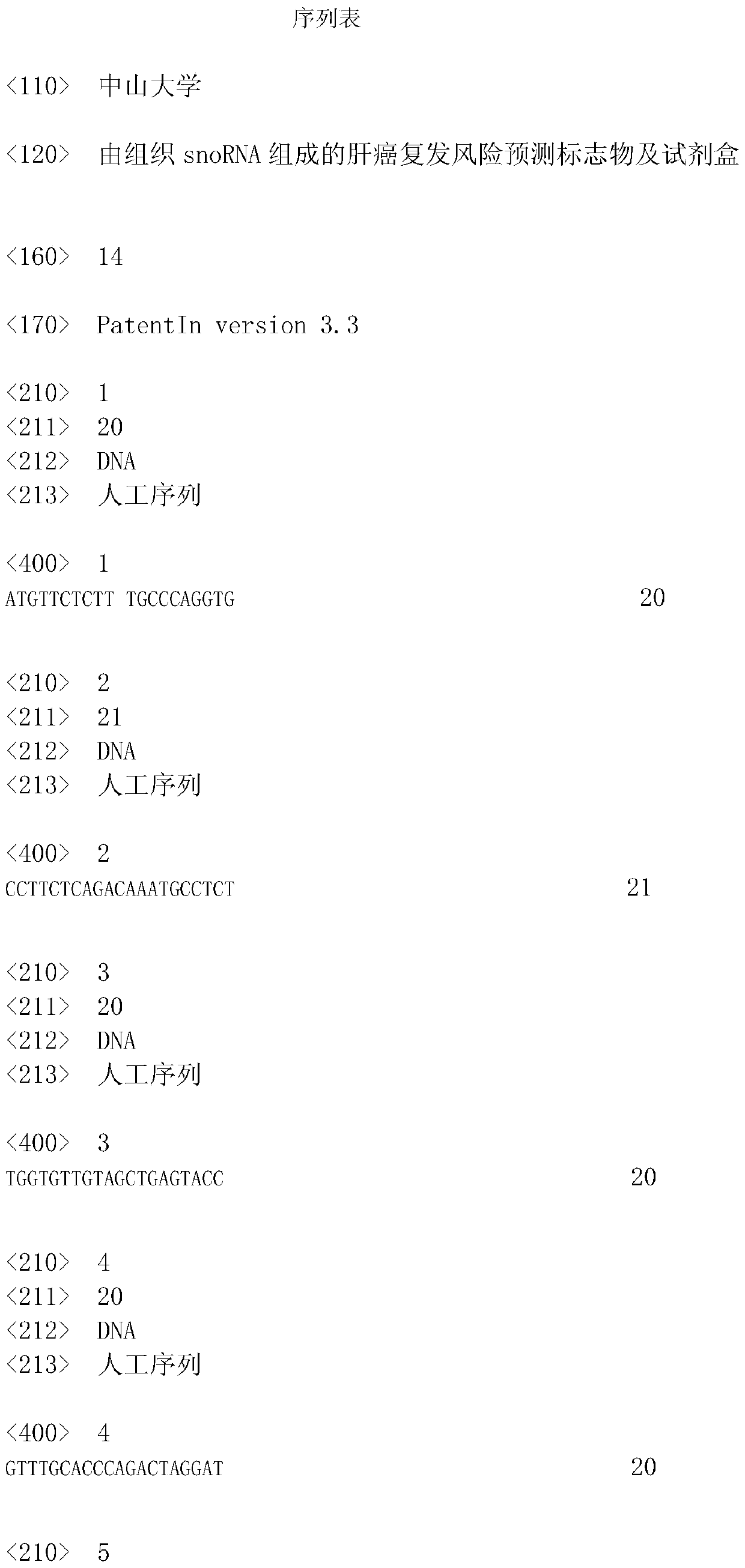Liver cancer recurrence risk prediction markers and kits composed of tissue snorna
A technology of markers and kits, which is applied in the field of detection kits for assessing the risk of recurrence after resection of patients with hepatocellular carcinoma, can solve the problems of difficulty in detection implementation, poor usability, and rarity, so as to avoid over-treatment and mature experimental methods , The effect of simple detection process
- Summary
- Abstract
- Description
- Claims
- Application Information
AI Technical Summary
Problems solved by technology
Method used
Image
Examples
Embodiment 1
[0033] Example 1: Collection and preparation of tumor tissue samples
[0034] The inventors collected tumor tissue samples from patients with liver cancer (HCC) who underwent liver cancer resection between January 2006 and November 2011. These populations met the following inclusion criteria, and according to the principle of gender and age matching, set liver cancer and its control samples. Inclusion criteria: (1) primary liver cancer, newly diagnosed and underwent radical surgical resection; (2) aged between 18 and 80 years old; (3) without extrahepatic metastasis at the time of diagnosis; (4) without liver cancer before operation Other malignant diseases, and no anti-cancer treatment before postoperative recurrence; (5) No symptoms of severe organ disorders after postoperative.
[0035] Training group: 174 cases of HCC tumor tissue samples who underwent liver cancer resection between January 2006 and December 2009.
[0036] Validation group: 109 cases of HCC tumor tissue ...
Embodiment 2
[0040] Embodiment 2: gene chip and its data analysis
[0041] The inventor selected 5 cases of liver cancer tissue and 3 cases of normal liver tissue (paratumor liver tissue of hepatic hemangioma) for gene chip screening. These specimens were obtained from patients undergoing radical resection of HCC or resection of hemangioma in 2005-2006, all were confirmed by pathology, and were frozen in liquid nitrogen immediately after resection.
[0042] The chip was produced by CapitalBioCorp, and a total of 281 snoRNA levels were detected. After calibration of the obtained raw data, the inventors used the Significant Analysis of Microarray (SAM) analysis method to select differential snoRNAs, and finally screened and obtained 28 candidate snoRNAs for subsequent verification: ACA3, U15a, U19, ACA21, ACA31, U31, U35B, ACA38, U35b, snR38c, U42B, U44, ACA52, U52, U53, U54, U58b, U60, ACA61, U70, U75, U78, U81, U106, HBII-142, HBII-296, HBII-202, HBII-420.
Embodiment 3
[0043] Embodiment 3: Real-time fluorescent quantitative PCR detects the level of snoRNAs in the specimens of the training group
[0044] 1. Tissue RNA Extraction
[0045] The present invention adopts Trizol reagent to extract, and specific steps are as follows: (1) for the tissue preserved in RNALater or liquid nitrogen, add 1ml Trizol ratio lysis cell by every 50mg tissue; Mix well, place at room temperature for 5 minutes, add 1 / 5 of the lysate volume of chloroform, oscillate and mix, and centrifuge at 4°C, 12000g for 15min; absorb the supernatant, add an equal volume of isopropanol, place at room temperature for 10min, and centrifuge at 4°C, 12000g for 30min (3) Discard the supernatant, wash the precipitate twice with 70% ethanol, pour off the supernatant carefully, add an appropriate amount of DEPC water to dissolve the RNA after the alcohol evaporates, and store it at -80°C for later use.
[0046] Table 2 The candidate snoRNA that the present invention adopts and the prim...
PUM
 Login to View More
Login to View More Abstract
Description
Claims
Application Information
 Login to View More
Login to View More - R&D
- Intellectual Property
- Life Sciences
- Materials
- Tech Scout
- Unparalleled Data Quality
- Higher Quality Content
- 60% Fewer Hallucinations
Browse by: Latest US Patents, China's latest patents, Technical Efficacy Thesaurus, Application Domain, Technology Topic, Popular Technical Reports.
© 2025 PatSnap. All rights reserved.Legal|Privacy policy|Modern Slavery Act Transparency Statement|Sitemap|About US| Contact US: help@patsnap.com



